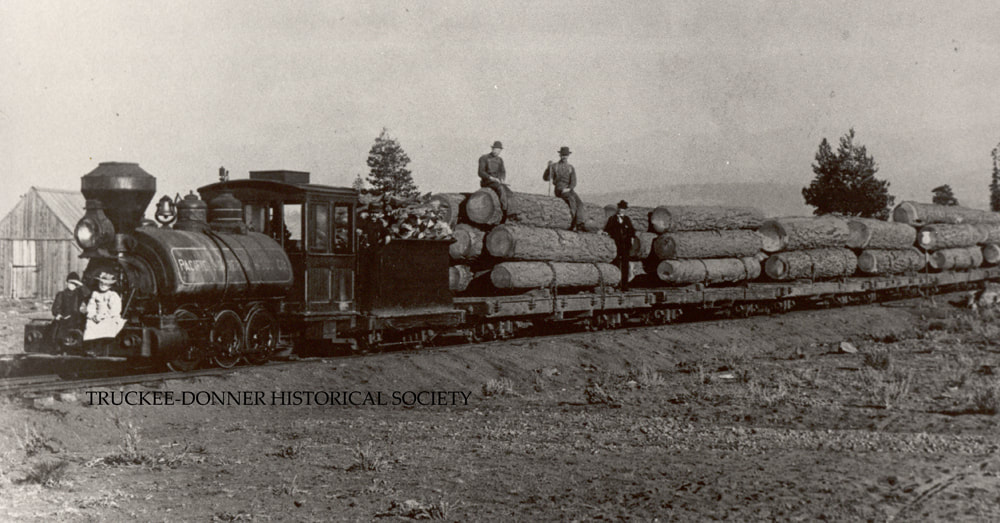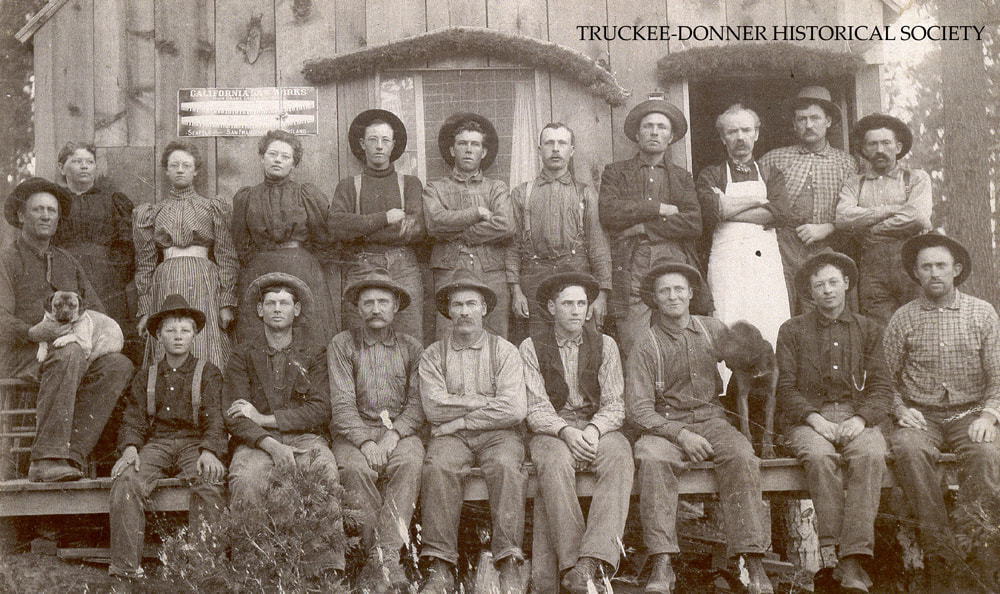Logging’s Importance to Truckee
By Judy DePuy*
The word of potential riches in the West, just waiting to be found, captured the nation and the world. The discovery of the 1859 Comstock Silver lode was just one of many opportunities that brought countless people to a new area, looking for a new life.
Mining in Nevada’s Comstock proved to be difficult. The ground was sandy and the mines would easily collapse. To protect the mines, and the miners, they had to support the weak and unstable walls and ceilings. This shoring required timber. Wood was needed not only for shoring but also for:
- Cordwood to feed the furnaces of the Comstock Stamp mills,
- Rails to lay for the railroad,
- Fuel to feed the locomotives, and
- Building materials for all the new towns being created.
The wood from the Sierras helped keep steady employment in the area. Early logging enterprises were from Joseph Gray, George Schaffer, EJ Brickwell, Elle Ellen, George Geisendorfer, and others. From 1864-1869 there were at least 13 operating mills in the Truckee area. Western mill towns were created to support not only single men but also families. These towns had strict rules with regards to alcohol and most everyone appreciated the focus to help build a community. (Those who did not appreciate the rules did appreciate Truckee with its numerous saloons and red-light district.)
Harvesting the trees was of the most importance. How soon and how many trees could be brought down to the mill? Truckee’s early logging methods were a unique mixture of animal- and steam-powered railways, log chutes and water transportation. The initial cutting areas were located along both sides of the Truckee River between Lake Tahoe and Truckee. The goal was to get the logs to the mills located close to the Truckee River and the railroad.
It is estimated that from 1879 to the early 1930s over 7 billion feet of saw timber and 10 million cords of fuel wood were harvested. The stripping of every tree was a goal of the early logging era in the Sierras.
But these hills were not clear cut like so many other areas.
Forest preserves were put in place in 1903 when 4 million acres were brought under government control. For our area it was the early work of several prominent families who set up the local mills and the rules around tree harvesting. Unbeknownst to them they set up rules that would help future generations. Trees cut had to be of a certain size which left an unintended seed tree method to be born. These leftover, scrawny saplings became our forests.
Let’s not downplay the devastation caused by forest harvesting. But what they did was to not kill all of our native tree species. Without these local saplings, whose species acclimated to the environment, we would be a different and potentially desolate place.
Reforestation continues today as we understand the necessity of wood and how it affects all parts of our lives. Wood is a renewable resource that can be planted, grown, harvested and replanted. It would do us well to work together and put back the trees that have earned the right to be here.
For more information on Truckee’s past and future, visit our new Museum of Truckee History, located at Truckee’s train depot in old town Truckee. [NOTE: Opening date TBD]
One way to help replenish our native trees is to plant a Sugar Pine…the tree with the largest pine cones and native to the Sierra. Visit https://sugarpinefoundation.org/ for the next seedling planting opportunity or to plant your own tree.
*About the Author:
Judy DePuy is a retired civil engineer, marketer, and volunteer for Truckee Donner Historical and Railroad Societies and Donner Summit Historical Society. Judy enjoys traveling, hiking, skiing, sewing, giving back to the community and sharing our town’s rich history.
(c) Truckee-Donner Historical Society 2020
Uploaded 2/11/2021 HCS
Mining in Nevada’s Comstock proved to be difficult. The ground was sandy and the mines would easily collapse. To protect the mines, and the miners, they had to support the weak and unstable walls and ceilings. This shoring required timber. Wood was needed not only for shoring but also for:
- Cordwood to feed the furnaces of the Comstock Stamp mills,
- Rails to lay for the railroad,
- Fuel to feed the locomotives, and
- Building materials for all the new towns being created.
The wood from the Sierras helped keep steady employment in the area. Early logging enterprises were from Joseph Gray, George Schaffer, EJ Brickwell, Elle Ellen, George Geisendorfer, and others. From 1864-1869 there were at least 13 operating mills in the Truckee area. Western mill towns were created to support not only single men but also families. These towns had strict rules with regards to alcohol and most everyone appreciated the focus to help build a community. (Those who did not appreciate the rules did appreciate Truckee with its numerous saloons and red-light district.)
Harvesting the trees was of the most importance. How soon and how many trees could be brought down to the mill? Truckee’s early logging methods were a unique mixture of animal- and steam-powered railways, log chutes and water transportation. The initial cutting areas were located along both sides of the Truckee River between Lake Tahoe and Truckee. The goal was to get the logs to the mills located close to the Truckee River and the railroad.
It is estimated that from 1879 to the early 1930s over 7 billion feet of saw timber and 10 million cords of fuel wood were harvested. The stripping of every tree was a goal of the early logging era in the Sierras.
But these hills were not clear cut like so many other areas.
Forest preserves were put in place in 1903 when 4 million acres were brought under government control. For our area it was the early work of several prominent families who set up the local mills and the rules around tree harvesting. Unbeknownst to them they set up rules that would help future generations. Trees cut had to be of a certain size which left an unintended seed tree method to be born. These leftover, scrawny saplings became our forests.
Let’s not downplay the devastation caused by forest harvesting. But what they did was to not kill all of our native tree species. Without these local saplings, whose species acclimated to the environment, we would be a different and potentially desolate place.
Reforestation continues today as we understand the necessity of wood and how it affects all parts of our lives. Wood is a renewable resource that can be planted, grown, harvested and replanted. It would do us well to work together and put back the trees that have earned the right to be here.
For more information on Truckee’s past and future, visit our new Museum of Truckee History, located at Truckee’s train depot in old town Truckee. [NOTE: Opening date TBD]
One way to help replenish our native trees is to plant a Sugar Pine…the tree with the largest pine cones and native to the Sierra. Visit https://sugarpinefoundation.org/ for the next seedling planting opportunity or to plant your own tree.
*About the Author:
Judy DePuy is a retired civil engineer, marketer, and volunteer for Truckee Donner Historical and Railroad Societies and Donner Summit Historical Society. Judy enjoys traveling, hiking, skiing, sewing, giving back to the community and sharing our town’s rich history.
(c) Truckee-Donner Historical Society 2020
Uploaded 2/11/2021 HCS


